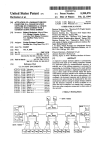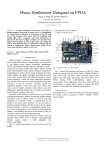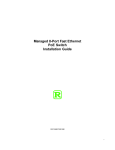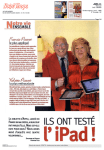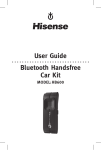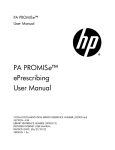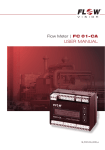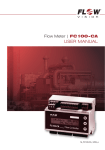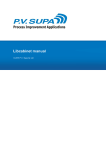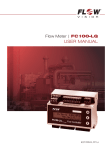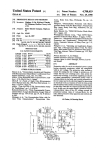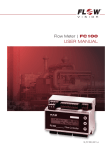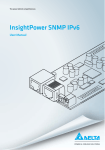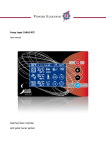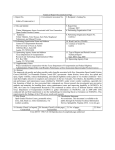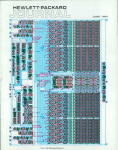Download IlllllllllllllIIIlllllllllllllllllllllllllIllllIlllllllllllllllllllllllllll
Transcript
IlllllllllllllIIIlllllllllllllllllllllllllIllllIlllllllllllllllllllllllllll
_
USOD5258908A
Umted States Patent [191
[11] Patent Number:
Hartheimer et al.
[45]
[$4] DETECTION AND PREVENTION OF
DUPLICATE TRADING TRANSACTIONS
OVER A COMMUNICATIONS NETWORK
_
'
[73] Assignee:
Austral'a
Foreign Exchange Transaction
Services, 1110., Long Island City, NY.
Nov. 2, 1993
OTHER PUBLICATIONS
"Quotron F/X Trader System Overview" 1990 Quo
tron Systems, Inc.
[75] Invcmofs: Rich?!‘ Hmheim?" Moms Plains’
N.J.; Michael Coleman, Sydney,
Almraha; Chris Klel'kl’ Parsippany,
Ni; G‘fof?’ey Poole, Sydney.
Date of Patent:
5,258,908
“Quotron F/X Trader User Manual" 1990 Quotron
systems, 1m;
Quotron Systems, Inc., "Interactive Demo Script",
with copies of display screens as shown in Lisbon, Por
tugal, Spring/Summer 1989.
Primary Examiner-Donald E- McElheny. J11
Assistant Examiner-Gita D. Shingala
Attorney, Agent, or Firm-Robbins, Berliner & Carson
[21] Appl. No.: 608,642
[57]
[22] “led:
A computer network system for simultaneously com
Nov- 2! 1990
5
municating between computer terminals at various bank
""""""""""""""""""""
' '
ABSTRACT
‘
[58] PM‘! of Search ’
locations for the purpose of entering a transaction for
235/379’_ 235/386
the exchange of currency of a selected currency pair
3/408 200 ‘800 401_
provides a method for preventing a trading communica
""""""" "
[56]
’ 235/379’ 386
’
tion involving a selected currency pair between two
banks wherein there is already a trading communication
References Cited
in progress between the two banks involving the same
us. PATENT DOCUMENTS
currency pm"
5,077,665 12/1991 Silverman et a1. ................ .. 364/408
13 Claims, 4 Drawing Sheets
941
BANK X
B44
c‘
BANK Y
111 \
T311
/
T112/B4T1.
_
C1
C2
c3
812 000000000 3m
B21 00000000 Bzui
Bsu'00000000 B32
T121 T12" T1M1 Tmz Tum T211 T21“
Tzm Tzum Tam TsuN
T321 Tszn
331?\ 312
US. Patent
Nov. 2, 1993
Sheet 3 of 4
INITIATE RFQ
(SELECT A BEsTINATIoN
\
BANK AND A CURR. PAIR)
LOCK
5,258,908
FIG. 3
16
ATOMIC LOCK
HAS
SELECTED
17
2/5
CURRENCY PAIR
FOR A TRADING
CONVERSATION WITH
THE SELECTED DESTINATIoN BANK BEEN
UNLOCK
REGISTER CURRENCY
PAIR FOR CON
VERSATION BETWEEN
BANI<s
l
/'
{UNLOCK
SEND RFQ To
DESTINATION BANK
18
THE CURRENCY
PAIR REGISTERED
AS A RESULT OF
PRINT MESSAGE
“REQUEST DENIED
CALL ALREADY
IN PROGRESS”
k
PRINT MESSAGE
uDUPLICATE CALL
IN PROGRESS”
k
|
1°
CALL MESSAGE
RECEIVED FROM
ALLOW NORMAL
COMMUNICATION BETWEEN
23
T
THE TERMINALS AT THE
ORIGINATING AND
DESTINATION BANKS
I
21\ CONVERSATION
TERMINATED
CONCLUSION OF
CONVERSATION
22\
WAIT FOR
‘ PRINT MESSAGE:
USER To
"DUPUCATE CALL
CLEAR PANEL
IN PROGRESS”
RE-REGISTER
I
CURRENCY PAIR
31
CONVERSATION
\
TERMINATED
3% I
I
COMPLETE POST DEAL
ACTIVITIES (IF ANY)
32
DE-REGISTER
\ CURRENCY
PAIR
US. Patent
Nov. 2, 1993
Sheet 4 of 4
REcEIvE RFQ
5,258,908
41
LOCK
AToMIc LOCK
17
26
HAS THE
CURRENSCEYLESIIERD FOR A
/
REGISTER CURRENCY
TRADING coNvERsATIoN
WITH THE oRIcINATINc
BANK NoDE BEEN
PAIR FOR CON
VERSATION BETWEEN
BANKS
REGISTERED
r
/"
I, UNLOCK
NOTIFY USER BY
N
46
PLACING RFQ IN
"INCOMING CALL"
cum:
I
ALLow NORMAL
coMMuNIcATIoN BETWEEN
47'» THE TERMINALS AT THE
ORIGINATING AND
DEsTINATIoN BANKS
SgNDL
DUPLICATE
. AI. MESSAGE
To ORIGINATING
TERMINAL
1v
“43
‘8
~
-
c NCLU I N
F
SDNVERSBgTIDTI
l
E
RE-REGISTER
‘9N
CURRENCY PAIR
I
COMPLETE POST DEAL
ACTIVITIES (IF ANY)
1
5,258,908
2
same currency pair. Generally, banks do not wish to be
in a situation where traders in the same bank are bidding
DETECTION AND PREVENTION OF DUPLICATE
TRADING TRANSACTIONS OVER A
COMMUNICATIONS NETWORK
against each other. This situation can happen quite by
accident, such as where two pairs of traders are un
knowingly engaged in a trading conversation involving
the same currency pair. Alternatively, “stereo” trading
TECHNICAL FIELD
The present invention relates generally to a computer
based trading system for trading transactions over a
may occur when a single trader knowingly engages in a
trading conversation with two different traders at the
communications network, and more particularly to a
same bank at the same time and concerning the same
method and apparatus for detecting and inhibiting any
currency pair.
attempt to initiate a second trading communication
SUMMARY OF THE INVENTION
In accordance with the method aspects of the present
which duplicates with an ongoing trading communica
tion involving the same principals and the same subject
invention, duplicate trading conversations involving the
matter.
15 same bank (or other identi?able principal) and the same
CROSS-REFERENCE TO RELATED
currency pair (or other speci?c subject matter) are
APPLICATIONS
avoided by automatically controlling access to the ter
For a more comprehensive view of what is presently
minals used to conduct such trading conversations. In
regarded as the best mode of practicing the invention
the particular example of a foreign exchange trading
20
and its intended environment, reference should be made
transaction between banks, the trading system automati
to the following commonly assigned to US. patent
cally determines whether a trading communication
applications ?led concurrently herewith:
currently exists between the initiating and destination
"Financial Exchange System Having Automated
banks which involves the selected currency pair, and
Recovery/Rollback of Unacknowledged Orders, " U.S.
inhibits
a second communication between the initiating
25
Ser. No. 608,643.
and destination banks involving the selected currency
"Activation of Dormant Bank Node Processor,” U.S.
pair.
Pat. Ser. No. 608,644.
To that end, the selected currency pair and destina
“Terminal for Automated Trading System having
tion bank is preferably registered in an associated look
up table maintained at the initiating bank before any
Streamlined User Interface," U.S. Ser. No. 608,645.
The following documents published by Quotron Sys
transaction communication with a destination bank
tems, Inc. describe various aspects of a trading system
which embodies many aspects of the present invention
and which is available for commercial use under the
trademark “F/X Trader”:
“Quotron F/X Trader System Overview,” Winter
1989/90.
“Quotron F/X Trader Beta Version User Manual,"
Spring 1990.
"Quotron F/X Trader Beta Version System Admin
istration Manual,” Spring 1990.
Copies of the foregoing documents are included as part
of this application and are hereby incorporated by refer
ence.
BACKGROUND ART
A typical transaction in the foreign exchange trading
industry involves two exchange traders (i.e., from dif
involving the selected currency pair is initiated, and is
de-registered at the conclusion of the trading communi
cation. In that case, the system is able to determine
35
whether a duplicate conversation is already in progress
merely by checking, in the relevant look-up table
entries, to see whether the selected currency pair and
counterparty is currently registered in an associated
look-up table.
Preferably the selected currency pair and counter
party for each trading conversation currently in
progress is registered not only at the initiating bank, but
also at the destination bank. In any event, it is advanta
geous to check the look-up tables at both banks associ
ated with a new trading conversation. To that end,
before a request for quote is communicated to its desig
nated recipient, the initiating bank checks its look-up
ferent banks) who enter into a communication for the
table for any duplicate trading conversation which it
purpose of trading currency at an agreed upon ex
might have previously initiated (and thus was registered
change rate measured at an agreed upon time. Transac 50 in the initiating bank's look-up table) and which is still in
tions such as these are initiated by a trader who, for
progress (and thus is not de-registered in the initiating
example, sends a request for quote (RFQ) to a second
bank’s look-up table); upon receipt of the request at the
trader (at another bank). The ?rst and second traders
can then negotiate the rate at which the currency pair
destination bank, the destination bank checks its own
look-up table for any other trading conversation which
which makes up the subject matter of the negotiations is 55
the destination bank might have previously initiated
with the initiating bank (and thus was registered in the
occur over relatively conventional means, such as the
destinations bank’s look-up table) and which is still in
telephone, or relatively newer means, such as a comput
progress (and thus is not de-registered in the destination
er-based communication network.
bank's look-up table). By this means, even in the un
Although the relative merits of the prior art systems
likely event that duplicate conversations were initiated
may be arguable as to their effectiveness for communi
simultaneously by traders at both banks (and thus there
cation, each of the prior art systems allow an undesir
would not be any duplicate pending transactions regis
able trading scenario to take place. Namely, the prior
to be exchanged. Presently, foreign trading transactions
tered when the conversations were initiated), both con
art systems allow for trading conversations to occur in
"stereo”. “Stereo" is a term of art describing the situa 65 versations would be automatically detected at their
respective destination banks and thus could be inhibited
tion where two different trading conversations are tak
before any potentially duplicate negotiations were per
ing place at the same time between a pair of banks, and
mitted to take place.
where each trading conversation concerns the exact
3
5,258,908
In accordance with the apparatus aspects of the in
vention, each look¢up table is preferably contained
within a bank node processor connected to all terminals
associated with a given bank, and each terminal is pro
vided with means to read and update the look-up table
at its associated bank node whenever a particular in
coming or outgoing trading conversation is initiated or
terminated, and to inhibit the initiation of any outgoing
4
the trading terminal T311. The path that the message
takes between the Tokyo C1 and Zurich C4 city nodes
is entirely up to the decision making function of the
network. For example, the message may go through
New York C2 only, or London C3 only, or both New
York and London before reaching Zurich.
There are a variety of messages and communications
which can occur between traders, however, the most
trading conversation which it determines is a duplicate
of another conversation already in progress. In accor
dance with another apparatus aspect of the invention,
fundamental is a communication regarding the negotia
tion of the sale or purchase of currency. Brie?y, in an
the terminal includes both means to transmit a duplicate
call message to a bank which initiates an incoming trad
by one trader requesting a quote (RFQ) from another
trader. The other trader has a variety of options, the
ing conversation which it determines is a duplicate cal],
?rst of which includes whether he will even answer the
exemplary system, the trading conversation is initiated
and means to terminate an outgoing trading conversa
RFQ. Other options include responding with a quote,
tion upon receipt of a duplicate call message from the
destination bank.
or sending written messages back to the requesting
party. The conversation is ended by either making a
deal or refusing a deal, and hanging up.
Referring now to FIG. 2, an exemplary trading termi
nal screen is shown having a plurality of panels. An
indicative rates panel 11 is provided and contains elec
BRIEF DESCRIPTION OF THE DRAWINGS
Other objects and features of the present invention
will be apparent from the following description of a
presently preferred embodiment taken in connection
with the accompanying drawings, in which:
tronically updated indicative trading rates for selected
currency pairs, wherein a currency pair is the two types
of currency which are to be involved in the potential
city network system having bank nodes connected 25 transaction. Example of currencies are the US. dollar
FIG. 1 is a system level schematic representation of a
thereto;
FIG. 2 is a schematic diagram illustrating an exem
plary display screen of the trading system having a
plurality of windows disposed therein;
FIG. 3 is a ?owchart illustrating the method of colli
sion detection when processing an outgoing request for
quote; and
FIG. 4 is a ?owchart illustrating the method of colli
sion detection when processing an incoming request for
(USD), the Great Britain pound (GBP), the Deutsch
[German] mark (DEM), the Japanese yen (J PY) and the
French franc (FRF).
An incoming call queue panel 12 is also provided.
This panel prioritizes and displays the incoming calls
arriving at the bank node to which the trading terminal
is connected. Calls may also be sent to a particular
trader, in which case this too is indicated in the incom
ing call queue panel. The remaining panels are conver
35 sation panels 13. It is in these panels that conversations
quote.
DETAILED DESCRIPTION OF THE
PREFERRED EMBODIMENT
Referring initially to FIG. 1, an exemplary network
of trading terminals is shown. The network comprises a
plurality of city nodes C1 to 04, each connected to at
least one bank node B11 to B4M. Each bank node is in
turn connected to at least one trading terminal T111 to
T3MN. The bank and city nodes generally provide a
routing network and supervisory functions to allow a
trading terminal connected to one bank node to commu
nicate with a trading terminal (or trading terminals)
connected to another bank node. The detail of the net
work structure is not important to an understanding of
the present invention. Suffice it to say that the city
nodes may be located in any city, and the city nodes
between traders take place. The six conversation panels
allow each trader to simultaneously conduct six trading
transactions. The subject matter of the simultaneous
transactions is unrestricted, except for the situation
where traders at two banks are attempting to negotiate
the same pair of currencies at the same time with each
other.
For example, referring brie?y to FIG. I, assume a
trader using terminal T111 at Bank X sends an RFQ
involving the US. dollar and Japanese yen to Bank Y.
As long as the request has been received by Bank Y and
at least has been placed in the incoming calling queue in
one or more trader terminals (more may have hap
pened, such as the call may be answered), any future
communication (other than the original one) between
these two banks concerning the same two currencies
may be connected in any combination necessary to
will be inhibited. Thus, if terminal T111 is engaged in
facilitate the routing of calls from city to city and from
bank node to bank node. For example, the city nodes
city node C1 is located in Tokyo, city node C2 in New
York, city node C3 in Zurich and city node C4 in Lon
communication with terminal T311, no terminal at Bank
X can be used to initiate conversation with any terminal
at Bank Y which relates to the same currency pair.
Similarly no terminal at Bank Y can be used to initiate
conversation with any terminal at Bank X which relates
don.
to the currency pair. Thus, both outgoing RFQs from a
may be located in the cities indicated in FIG. 1 wherein
The route over which messages are routed is invisible
party (the initiation of the request), and incoming RFQs
to the traders using the trading terminal. For example, a 60 from a counter-party (the reception of the request) are
foreign exchange trader using the trading terminal T111
in Bank X in Tokyo can communicate with a foreign
trader using the terminal T311 at Bank Y in Zurich. The
message from Bank X to Bank Y initiates at terminal
T111, is routed through the Bank X bank node B11 and
then through the Tokyo city node Cl. Upon receipt of
the message at Bank Y, it gets routed to the Zurich city
node, then to the Bank Y bank node B31 and ?nally to
blocked. These features will be discussed at length be
low.
Referring now to FIG. 3, when a trader initiates an
RFQ 16, the trader selects a destination bank (he may
also select a specific trader terminal, but he must always
identify the bank) and he identi?es the currency pair for
which he requests a quote. Once the RFQ is initiated,
the system determines whether the identi?ed currency
5
5,258,908
pair is currently the subject of a transaction conversa
tion between the originating bank and the destination
bank 17. In an exemplary embodiment, the system ac
complishes this by doing a table look~up and seeing
whether the currency pair has been registered for the
current pair of banks wishing to engage in communica
tion.
For example, if a trader at Bank X wishes to engage
in a trading conversation with a trader at Bank Y re
garding the U.S. dollar and Japanese Yen, he initiates
the process by inputting the destination bank and the
selected currency pair at his terminal. The trader's ter
minal at Bank X will then initiate a table look-up at its
associated bank node processor to determine whether
the U.S. dollar and Japanese Yen currency pair has been
registered for a trading conversation between Bank X
and Bank Y.
6
cate call message 28. The conditions under which this
message is sent from a destination bank will be consid
ered below (in conjunction with FIG. 4).
If the duplicate call message has been received by the
originating bank, then the process proceeds to display
an appropriate message 29 on the terminal screen, the
conversation is automatically terminated 31, and the
conversation panel merely permits the user to clear the
panel for use by another conversation. Further, the
currency pair is de-registered 32. Note that the cur
rency pair is only de~registered at the bank which initi
ated the RFQ. Thus, if this bank were to once again
initiate an RFQ to the same bank, it would not be able
to open a conversation with the other bank. Although
the bank node processor does not list the currency pair
as registered when it tries to send the RFQ, the proces
sor would subsequently receive a duplicate call message
since the destination bank has registered the pair.
If the currency pair has already been registered, this
If, however, the duplicate call message is not re
indicates that the currency pair is the subject matter of
an outgoing request from the originating bank or an Z0 ceived from the destination bank (in step 28), the initi
ated RFQ reaches its destination and is placed in the
incoming request from the destination bank. The cir
incoming call queue panel on the terminals of the desti
cumstances under which a currency pair can become
nation bank. Normal communications are then allowed
registered will be apparent after reading the entire spec
to occur between the party and counter-party. "Normal
i?cation.
After determining that the currency pair has been 25 communications” include a variety of options which are
not relevant to the understanding of the present inven
registered, the next step 18 is to determine whether the
tion. Brie?y, they can include answering the call, mak
registration was the result of a prior initiated RFQ or a
ing offers, making counter offers and sending messages.
prior received RFQ. If the registration was the result of
Normal communication continues until the trading
a prior initiated RFQ, the next step 19 is to print a mes
sage on the originators terminal. In an exemplary em 30 conversation is concluded 34. This too may occur in
several ways. First a deal may be reached, but also one
bodiment, the message can read: "Request Denied. Call
Already in Progress." The result of reaching this step is
of the parties may terminate the conversation by hang
ing up or the time may expire in which one of the parties
that the conversation or potential conversation between
was supposed to engage in an action. If the conversation
the two banks is terminated 21, and the conversation
panel in which the conversation was to take place 35 concludes in the making of a deal (the parties reaching
an agreement and binding themselves to it), there are
leaves the user only one option 22, that being to clear
typically some post deal activities, such as recording the
the panel.
deal, that must be completed. However, in the trading
If it is determined that the registration of the cur
system, the parties are obligated once the deal is made.
rency pair was the result of receiving a RFQ, the next
step 23 is also to print a message on the originator’s 40 Therefore, immediately after this point, and prior to
beginning the post-deal activities, the system de-regis
terminal. In an exemplary embodiment, the message can
ters the currency pair 36. Although FIG. 3 concerns
read: "Duplicate Call In Progress." Here also, the con
only the flow of an initiated RFQ, it will be seen below
versation is automatically terminated 21, and the con
that the system de-registers the currency pair following
versation panel in which the conversation was to take
place merely presents the duplicate call message and 45 the conclusion of a conversation where the currency
pair was registered as a result of an incoming, or re
permits the user to clear the panel 22.
ceived, request for quote.
The key is that under both of the above conditions,
It should also be understood, as shown in FIG. 3, that
the conversation is automatically terminated. It should
the currency pair will be de-registered after any type of
be apparent to a person skilled in the art that any mes
sages can be generated in response to the above condi 50 conclusion of conversation, including those not involv
ing the making of a deal.
tions. The messages de?ned in the above described
Referring now to FIG. 4, when a request for an RFQ
embodiment simply convey additional information to
is received by a terminal at a particular bank node 41,
the trader as to why the conversation was terminated.
the bank node processor's look-up table is immediately
If, at the step of determining whether the currency
pair has been registered 17, it is found that the currency 55 checked to see if the currency pair involved in the re
quest has been registered for the banks involved in the
pair has not been registered, then the system immedi
potential trading communication 17. If the currency
ately registers the pair in the next step 26. In an exem
pair has been registered, then a duplicate call message is
plary system, this is accomplished by conventional
sent to the originating bank 43. (This duplicate call
means such as registering the currency pair in a table (or
stack) corresponding to the particular pair of originat 60 message will be received by the originating bank and
will result in a message being displayed at the originat
ing and destination banks.
ing terminal along with the freezing of the conversation
In the following step 27, the RFQ is actually sent to
panel). In the exemplary embodiment, no message is
the destination bank. The effect at the destination bank
displayed at the receiving bank’s terminals. Note that
is that the RFQ request is placed in the incoming call
queue panel of each terminal at the destination bank (or 65 the received RFQ is not even displayed in the incoming
call queue panel.
one terminal if a speci?c terminal is speci?ed). The
If, however, the currency pair in the RFQ has not
originating bank's system then determines whether the
been registered, the system immediately registers it 26.
destination bank has sent the originating bank a dupli
7
5,258,908
in the following step, the traders at the receiving bank
are noti?ed by placing the received RFQ in the incom
ing call queue panel of the bank’s terminals 46. As in the
case where the RFQ is initiated rather than received,
normal communication between the banks is allowed 47
for the present RFQ. At the conclusion of the conversa
tion 48, the currency pair is de-registered 49.
it is important to note that the registration of cur
rency pairs occurs at the bank node, and thus the regis
tration of a currency pair affects all of the trading termi
nals connected to the bank node. Thus, as brie?y de
scribed above, when a ?rst trader at Bank X, for exam
8
RFQ is being processed by the checker function, the
box is locked and the bank node processor cannot begin
to process any other RFQ until the box in unlocked.
The only way to unlock the box is for the original RFQ
to be disposed of in some way, either by determining
that the currency pair has been registered, or by regis
tering it if it has not been registered.
If these functions were not atomic, then potentially a
second RFQ could pass through the checking step prior
to the bank node performing the registering step 26 in
response to a ?rst RFQ.
It should be understood that there is only one check
and register function in each bank node processor, and
ple trader using terminal T111, initiates an RFQ di
that all RFQs initiated and received by that bank node
rected at Bank Y for a speci?ed currency pair, a second
trader at Bank X will be prevented from using the other 5 must be processed by the single check and register func
terminals at Bank X to send an RFQ to Bank Y concern
tion. Obviously, this prevents the check and register
function from being done in parallel. In the race condi
tion previously described, one of the RFQs must be
3, when the second trader at Bank X attempts to initiate
processed before the other. The ?rst one processed will
the RFQ, a common look-up table maintained at the
bank node processor and accessible to all the bank’s 20 be sent to the destination bank, but the second one will
be stopped. This is true even where the requests are
trader terminals is checked for the prior registration of
initiated at exactly the same moment in time. Since the
the currency pair. As long as the initial request to Bank
check and register is a serial atomic operation, one of
Y has not been concluded, the currency pair will be
the RFQs must be processed ?rst.
registered, the second conversation will automatically
Another race condition is considered by the system to
be terminated, and a message indicating this will be 25
avoid duplicate trading conversations. Namely, where
displayed on the second traders terminal.
two banks, Bank X and Bank Y for example, simulta
Similarly, any trader at Bank Y will be prevented
neously, or nearly simultaneously, initiate RFQs to each
from sending an RFQ to Bank X concerning the same
other for the same currency pair. in this case, when
currency pair. Thus, referring to FIG. 3 once again,
each bank node checked its table to see if the currency
when the second trader at Bank Y attempts to initiate
pair had been registered, it would not find the currency
the RFQ, Bank Y’s bank node processor will ?nd that
pair to be registered (since neither bank node has re
the currency pair has already been registered. In this
ceived the RFQ from the other bank). Thus, each bank
case, the registration will have taken place as a result of
node would be able to send out the RF Q. However, as
the reception of the initial RFQ from Bank X. The
second trader at Bank Y will thus be unable to send the 35 the RFQ is received by each bank, the check function of
each bank’s bank node processor will ?nd that the cur
RFQ.
rency pair has already been registered, and thus will
Of course, the same principles apply where one of the
send a duplicate call message back to the originating
traders who is a party to the original transaction at
bank. Therefore, neither of the RFQs will result in a
tempts to initiate a second conversation with a different
trader at the counter-party's bank. For example, if the 40 trading conversation.
ing the same currency pair. Speci?cally, following FIG.
original RFQ originator at Bank X attempts to gain
The same result may occur whenever two banks are
trying to request a quote from each other regarding the
same currency pair, and the RFQ from a ?rst bank is
initiated prior to its receiving the RFQ from the second
second call, the bank node processor will indicate to his 45 bank. Note that, if the RFQ is received before an RFQ
is initiated, the received RFQ has priority in the atomic
terminal that the currency pair has been previously
check and register function, and will block out the initi
registered as a result of his initial call between Bank X
ated RFQ. When the RFQ is initiated before the RFQ
and Bank Y.
from the second bank is received (and the initiated RFQ
Race conditions, for example, where two traders at
has not yet been received by the second bank before it
Bank X attempt to reach a trader at Bank Y at substan
access to a second trader at Bank Y (for example, to try
to receive more than one bid from the same source), be
will be refused access since, when he tries to initiate the
tially the same moment, are taken into account in the
sends out its RFQ), there is an electronic race between
present system to insure that two trading conversations
concerning the same currency pair do not occur. Spe
ci?cally, the steps (17 and 26) shown in FIG. 3, wherein
the bank node processor checks for a prior registration
and then registers the currency pair if no registration is
found, are an atomic (i.e., uninterruptable) operation.
Thus, both of these operations must be completed with
regard to one RFQ before the following RFQ is oper
the bank nodes and the transmission of the signals.
Namely, the bank that sends its RFQ ?rst will get back
ated on.
One way to visualize this is to imagine a box sur
rounding the steps (the dotted line shown in FIG. 3).
The box has one entry, namely, the path between the
initiation of the RFQ and the step determining whether
a message that a duplicate call is in progress since the
currency pair is registered in the second bank. when it
receives this message, the conversation is terminated,
thus de-registering the currency pair for that bank node
(of the ?rst bank). Meanwhile, a terminal at the second
bank node is trying to send an RFQ to the ?rst bank. If
the sent RFQ is checked by the ?rst bank node proces
sor before it can de-register the currency pair, then a
message is sent back to the terminal at the second bank
node and the conversation is terminated (thus neither of
the bank nodes were successful in entering into a trad
the currency pair is registered, and two exits, one fol 65 ing conversation with the second bank). However, if
the ?rst bank node processor can clear and de-register
lowing the determination that the currency pair has
the currency pair before it checks the RFQ sent from
been registered and the other being after a previously
unregistered pair has been registered. Once an initial
the second bank node, the RFQ will be accepted into
9
5,258,908
the incoming call queue maintained by the ?rst bank
node.
The time it takes for messages to be sent depends
primarily on the route that the city network provides
and the speed with which the messages travel through
the city network. The messages between the two bank
nodes do not necessarily have to travel the same route.
It is important to note that in a race situation, the elec
tronic race may result in one trading conversation be
tween the two banks. However, the race will never in.
result in two simultaneous trading conversations re
garding the same currency pair between the same two
banks.
While the invention has been shown and described
with reference to a presently preferred embodiment, it
is understood by those skilled in the art that numerous
changes in form and detail may be made therein without
departing from the scope of the invention.
For example, the invention is applicable to any com
munications network used to conduct trading transac
tions of any kind. Thus, the traders may not be banks, or
the banks described above can deal through third
parties, such as brokers. Here, the principals will use
trading terminals at "broker nodes” rather than bank
nodes. Also, the subject matter of the trading conversa
tion can be practically anything that a trading market
exists for, such as bonds or precious metals, for example.
We claim:
1. In a computer network system allowing a plurality 30
of simultaneous trading communications between re
spective computer terminals at an initiating bank loca
tion and a destination bank location for the purpose of
executing a respective plurality of transactions for the
exchange of respective currency pairs, a method for
automatically controlling the access of terminals com
prising the steps of:
selecting a currency pair;
automatically ascertaining whether a trading commu
nication currently exists between the initiating and
destination bank locations which involves the se
lected currency pair;
inhibiting a second trading communication between
the initiating and destination bank locations involv
ing the selected currency pair; and
45
registering the selected currency pair in a look-up
table at the initiating bank each time the initiating
bank initiates a transaction communication with
the destination bank involving the selected cur
rency pair.
2. A method as recited in claim 1 wherein
the ascertaining step comprises the step of checking
the look-up table at the initiating bank to determine
whether the selected currency pair has been regis
~
tered.
3. A method as recited in claim 1 further comprising
the step of
de-registering the currency pair at the conclusion of
the trading communication.
10
automatically ascertaining whether a trading commu
nication currently exists between the initiating and
destination bank locations which involves the se
lected currency pair;
inhibiting a second trading communication between
the initiating and destination bank locations involv
ing the selected currency pair; and
registering the selected currency pair in a look-up
table at the destination bank each time the destina
tion bank receives a request for a transaction com
munication from the initiating bank involving the
selected currency pair.
5. A method as recited in claim 4 wherein
the ascertaining step comprises the step of checking
the look-up table at the destination bank to deter
mine whether the selected currency pair has been
registered.
6. A method as recited in claim 4 further comprising
the step of
de-registering the currency pair at the conclusion of
the trading communication.
7. In a computer network system allowing a plurality
of simultaneous trading communications between re
spective computer terminals at an initiating bank loca
tion and a destination bank location for the purpose of
executing a respective plurality of transactions for the
exchange of respective currency pairs, a method for
automatically controlling the access of terminals com
prising the steps of:
selecting a currency pair;
automatically ascertaining whether a trading commu
nication currently exists between the initiating and
destination bank locations which involves the se
lected currency pair;
inhibiting a second trading communication between
the initiating and destination bank locations involv
ing the selected currency pair; and
inhibiting the transaction communication at each of
the initiating and destination banks wherein the
initiating bank initiates a trading communication
with the destination bank involving the selected
currency pair at substantially the same time as the
destination bank initiates a trading communication
with the initiating bank involving the selected cur
rency pair.
8. A method as recited in claim 7 wherein each bank
performs
an initiating registration of the trading communica
tion, involving the selected currency pair between
the initiating and destination banks, upon the initia
tion of a trading communication, and
a receiving registration of the trading communica
tion, involving the selected currency pair between
the initiating and destination banks, upon the recep
tion of a trading communication.
9. A method as recited in claim 8 wherein
the inhibiting step only inhibits both trading commu
nications where each bank receives a request for
trading communication prior to registering its initi
ating trading communication.
4. In a computer network system allowing a plurality 60
10. In a computer network system allowing for the
of simultaneous trading communications between re
simultaneous communication between computer tenni
spective computer terminals at an initiating bank loca
nals at an initiating and destination bank location for the
tion and a destination bank location for the purpose of
purpose of entering a transaction for the exchange of
executing a respective plurality of transactions for the
exchange of respective currency pairs, a method for 65 currency, a method for automatically controlling the
access of terminals comprising the steps of:
automatically controlling the access of terminals com
initiating a request for quote (RFQ) by selecting a
prising the steps of:
destination bank and a currency pair;
selecting a currency pair;
11
5,25 8,908
12
ascertaining whether the selected currency pair has
12. In a computer network system allowing for the
been registered for the a transaction communica
tion with the selected destination bank;
if the selected currency pair has been registered then:
simultaneous communication between computer termi—
nals at a requesting and destination bank location for the
purpose of entering a transaction for the exchange of
currency, a method for automatically controlling the
access of terminals comprising the steps of:
receiving a request for quote (RFQ) from a request
automatically ending the transaction communica
tion; and displaying a message on the terminal indi
cating that the RFQ cannot be sent;
if the selected currency pair has not been registered,
ing bank, the RFQ identifying a currency pair to be
the subject of a transaction communication;
ascertaining whether the identi?ed currency pair has
been registered for a trading communication with
then: registering the currency pair;
sending the RFQ to the destination bank;
ascertaining whether a duplicate call message has
been received from the destination bank;
if the duplicate call message has been received, then
the requesting bank;
automatically ending the transaction communica
if the currency pair has been registered, then sending
a duplicate call message to the requesting bank; and
tion and displaying a message on the terminal indi
if the currency pair has not been registered, then:
cating the same;
if the duplicate call message has not been received,
then allowing the transaction communication be
tween the originating bank and the destination
20
bank to proceed; and
de-registering the currency pair at the conclusion of
the transaction communication.
between the banks; and
ale-registering the currency pair at the conclusion
of the transaction communication.
13. A method as recited in claim 12 wherein the as
certaining and registering steps form a single atomic
11. A method as recited in claim 10 wherein the as
operation.
certaining and registering steps form a single atomic
operation.
registering the currency pair;
placing the request in the incoming call queue;
allowing for normal transaction communication
25
35
45
55
65
i
i
t
t
i











